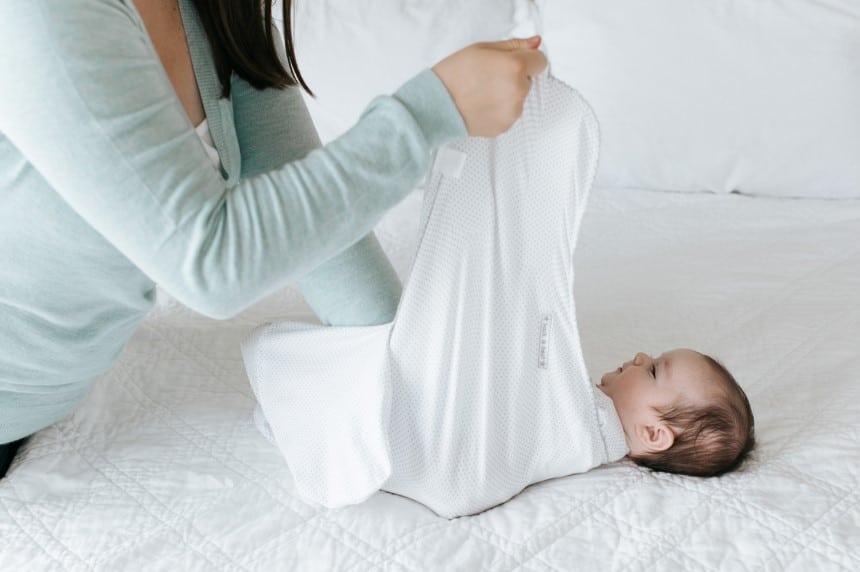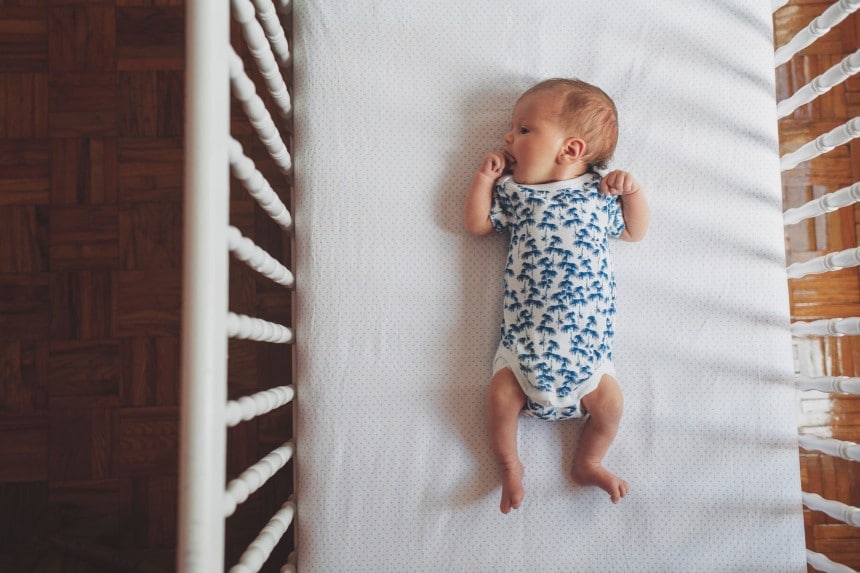

Babies are cute little bundles of joy, but when it comes to rules and recommendations about raising them, there are so many that it can make your head spin. One of the biggest debates is when a baby can sleep with a blanket? Past generations and perhaps your own baby photos show cribs decorated with blankets, pillows, and baby bumpers. These days parenting blogs and health experts recommend not using any of that and keeping your baby’s bed free of anything.
When it comes to babies, you can’t take any chances. Navigating every single risk for babies can be rather exhausting, but it’s necessary to keep them safe while they sleep. Have you ever heard about SIDS? Sudden Infant Death Syndrome is an unexplained death, usually during the sleep of a seemingly healthy baby that is less than a year old. This unexplained death has led experts to recommend not putting anything in the crib with the baby as it could increase the risk of death. A newborn nest may be the perfect place to keep your baby safe while they’re dreaming.
The function of a blanket is to keep your baby warm, but if a blanket increases the risk of SIDS, when should you give your baby a blanket for the first time? Up until the age of 12 months, babies are extremely fragile, and for safety’s sake, you shouldn’t give your baby a blanket before then. The only item that should be in the crib is a firm crib mattress.
This article shows you how quickly SIDS can occur Trusted Source Advice call on sleeping with babies after Neyland death Pembrokshire coroner Mark Layton said there was “some controversy” over the advice in the Welsh government’s document Reducing the Risk of Cot Death and he would be putting his concerns in writing. www.bbc.com . A safe alternative to a blanket is items like a sleeping sack, footed sleeper, or pajamas. This will keep your baby at the right temperature without putting them at risk of suffocation.

Recharging during sleep is especially important in babies as they grow at a rapid pace during those first 12 months of life. So, good sleep is vital. Have a look at this interesting article about the connection between the baby’s body and brain during sleep.
Stop swaddling your baby for bedtime as soon as you see signs of movement, like rolling in your baby’s daily actions. Once they start to roll over, swaddling is no longer safe. When your baby is very little, you can also use special pillows that help to keep the baby’s head positioned correctly.
When living in colder climates, you may need to layer your child’s clothing. Start with a diaper, then an undershirt, then thin pajamas. The baby can then be placed in a footed sleeper. If it’s snowing or extremely cold, then you can add a sleeping sack.
When it’s the hot summer months, dress the baby in a single layer of clothing, an undershirt, or just a diaper. Control the temperature in the room by adjusting the thermostat. The room should be cool and comfortable.
Even with managing temperature and comfort, sleep regression is a serious issue you as a parent will need to deal with. During this time, the sleep patterns will change, with babies waking up often. For guidance, here’s what to do when your baby goes through an 11-month sleep regression.
There is no golden age where it suddenly becomes safe for your baby to sleep with a blanket. Once a child has more motor control, you can start introducing a blanket safely. You know your child better than anyone else, so you will know once they are ready. The child should be able to roll over unassisted and have full use of their arms and legs. If there is a risk of the child becoming tangled in the blanket, then rather hold off until they can untangle themselves easily.
Many parents put a blanket over a small baby, and nothing bad happens, but in other cases, it could lead to SIDS. As a parent, you need to decide for yourself what you think the correct age is to give your baby a blanket.
Another question is when you should introduce a pillow to the crib? Experts recommend after the child turns one. If you’re looking for the perfect pillow, take a look at this guide.
The first tip is to have a safe place for your baby to sleep. This could be a pack and play, crib, or bassinet. It’s important to ensure that your crib meets the latest safety standards. Avoid cribs with a dropped railing, as these have been banned since 2012. Another item that has been banned recently is inclined sleepers. You can check out this article Trusted Source Stop using all inclined sleepers, warns federal safety agency as death toll hits 73 - The Washington Post The Consumer Product Safety Commission’s new warning applies to any sleeping device that allows babies to sleep at an angle greater than 10 degrees. www.washingtonpost.com to find out more. The mattress you use should be firm.

Other tips include:
If you’re looking for some extra tips from the experts to keep your baby sleeping for longer, check out this article. Some parents choose not to follow the recommended sleeping tips. Check out this article Trusted Source Why some parents don’t follow the “safe sleep” recommendations for babies - Harvard Health The very thought of losing a baby to sudden infant death syndrome (SIDS) is terrifying. Safer sleeping practices for infants have greatly reduced the number of babies lost to SIDS, but many parents are unclear on the reasons behind these recommendations and therefore often don’t follow them. www.health.harvard.edu to find out more information if you don’t know yet what to choose for your child.
Answering the question of when a baby can sleep with a blanket is quite tricky. To be safe, don’t give your child a blanket before the age of one. As a parent, you need to ask yourself what’s best for your child. There are many other alternatives, such as sleep sacks and footed sleepers, so it’s best to be safe rather than sorry. Keeping your child safe is your top priority as a parent, so trust your instincts—and a few experts—and happy parenting.